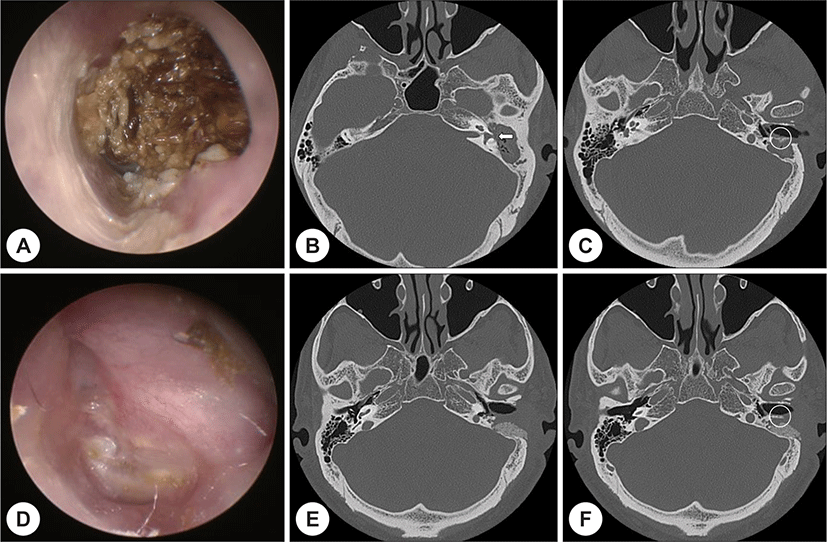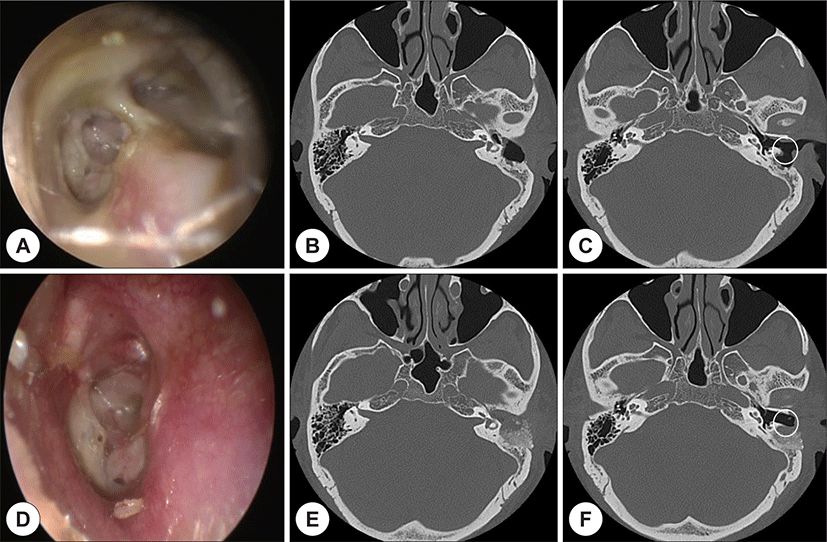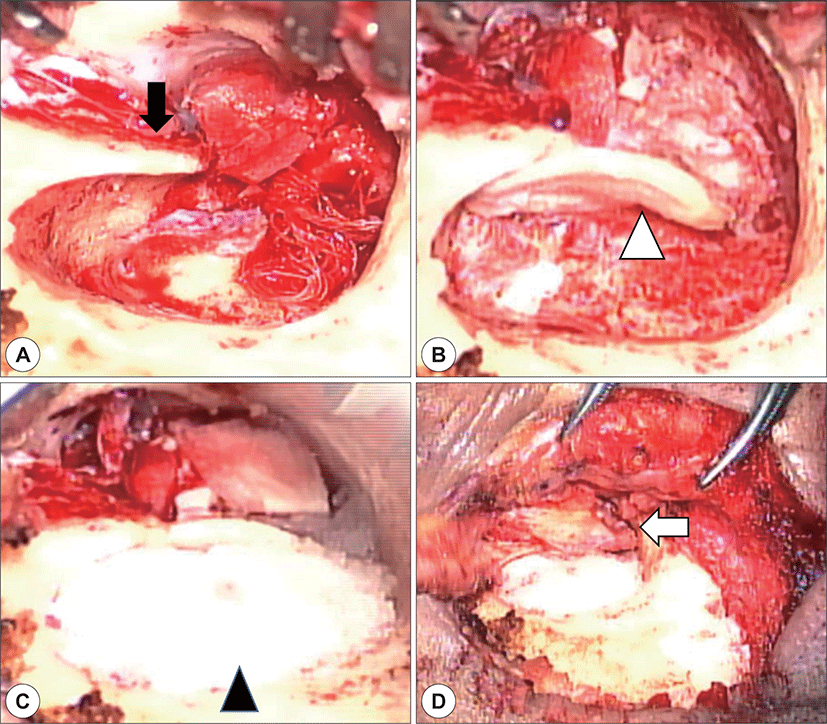서 론
진주종성 중이염의 치료 원칙은 진주종의 완전 제거, 재발의 방지 그리고 청력 보전에 있으며, 이를 위해 주로 개방형 유양동 삭개술(canal wall down mastoidectomy) 등을 시행하고 있다. 개방형 유양동 삭개술은 진주종을 제거할 수 있는 충분한 시야를 제공하여, 진주종 제거 및 재발을 방지하는데 유리하지만,1) 수술 후 회복기간이 길 며, 필연적으로 공동을 형성하게 되어, 정기적인 공동 청 소가 필요한 공동 문제(Cavity problem)가 생긴다. 또한 반규관 자극에 의한 어지러움, 보청기 선택 시 어려움이 존재한다.2,3) 이를 극복하기 위해 근골막 피판, 연골, 피 질 골분 등을 사용하여 외이도 후벽 재건술 및 유양동 폐 쇄술(mastoid obliteration)을 시행하고 있으나, 시간이 지날 수록 물질이 자연 흡수되어 외이도가 넓어지는 부 작용이 있다.4-6) 이에 본 저자들은 외이도 후벽의 상부에 만 침범이 있고 하부는 침범이 없는 진주종성 중이염을 가진 환자군에서 외이도 후벽 하부의 일부분을 남기고 개방형 유양동 삭개술을 시행한 뒤 유양동 폐쇄술과 외 이도 후벽 재건술을 성공적으로 시행한 4예(Table 1)를 치험 하였기에 문헌고찰과 함께 보고하고자 한다.
| Patient | Sex/age | Diagnosis | Past history | Lesion of cholesteatoma | Surgery17) | Reconstruction | Follow-up periods (month) |
|---|---|---|---|---|---|---|---|
| 1 | M/70 |
Attic cholesteatoma [L], Labyrinthine fistula [L] |
None | Epitympanum, aditus, mastoid cavity, lateral semicircular canal |
CWD c POR [L] fistula repair [L] |
Concha cartilage, DBM, Ant.based flap | 4 |
| 2 | M/58 | Recur.Cholesteatoma [L] | CWD state [L] | Epitympanum, aditus, mastoid cavity | CWD [L] | Concha cartilage, DBM, bone chip, fascia, Ant.based flap | 5 |
| 3 | F/74 |
Recur.Cholesteatoma [R] Labyrinthine fistula [R] |
CWU state [R] | Mesotympanum, epitympanum, aditus, mastoid cavity lateral semicircular canal |
CWD c T3 [R] fistula repair [R] |
Concha cartilage, DBM, megaderm, Ant.based flap | 2 |
| 4 | M/35 | Attic Cholesteatoma [R] | None | CWD c Tl [R] | Concha cartilage, DBM, fascia, Ant.based flap | 2 |
증 례
70세 남자가 1년 전부터 좌측 귀에 이물이 들어갈 시 어지러움이 발생하였으며, 내원 3일 전부터는 좌측 안 면마비가 발생하여 내원하였다. 고혈압 외 다른 과거력 은 없었다. 신체 진찰에서 House-brackmann grade 3 의 좌측 안면마비가 있었으며, 고막 내시경 검사에서 좌 측 외이도 후벽을 침범한 진주종이 관찰되었다(Fig. 1A). 측두골 전산화단층촬영상 상고실(epitympanum) 및 유양동(mastoid cavity)에 진주종으로 의심되는 연부 조직 음영이 관찰되었으며, 안면신경 침범이 동반되어 있었고, 수평반규관누공 소견도 관찰되었다(Fig. 1B, C). 진주종의 제거를 위해 개방형 유양동 삭개술을 계획 하였다. 수술은 전신 마취 하에 후이개 절개술을 시행한 후 고막 재건 및 유양동 폐쇄를 위해 측두 근막을 채취 하였고, 유양동 폐쇄를 위해 전방 기저 근골막 피판(anterior based musculoperiosteal flap)과 이개 연골을 준 비하였다. 이 후 개방형 유양동 삭개술 및 상고실절제술 (epitympanectomy)을 시행하였다. 개방형 유양동 삭개 술은 고전적인 개방형 유양동 삭개술과는 다르게 진주 종을 충분히 제거할 수 있을 정도로만 외이도 후벽을 제 거하고 가능한 외이도 후벽의 하부를 남겨두었다(Fig. 3A). 유양동을 Tissue glue(Tisseel®, Baxter Healthcare) 을 섞은 동종 골기질(demineralized bone matrix: Regenafil®; Regeneration Technologies Inc., FL, DBM) 로 폐쇄하며 외이도 후벽의 모양을 만든다. 진주종 제거 를 위해 제거된 외이도 후벽의 결손 부위는 연골을 덮어 외이도의 모양을 완성하였다(Fig. 3B, C). 연골 위는 측 두 근막으로 덮고 그 위에 근골막 피판과 외이도 피부로 덮었다(Fig. 3D). 외이도 안에는 Silastic sheet 삽입 및 거즈패킹을 통해 외이도의 모양을 유지하였다. 술 후 4 개월 뒤 고막 내시경 검사에서 고막 천공이 있으나, 좌 측 외이도 후벽이 유지되있음을 확인하였다(Fig. 1D). 측두골 전산화단층촬영상 유양동 폐쇄술 및 외이도 후 벽이 유지되있음을 확인하였다(Fig. 1E, F).



59세 남자로 10년 전에 좌측의 진주종성 중이염으로 타 병원에서 개방형 유양동 삭개술을 받았던 과거력이 있으며, 최근 이루가 다시 발생하여 내원하였다. 고막 내시경 검사에서 좌측 외이도 후벽을 침범한 진주종이 관찰되었다(Fig. 2A). 측두골 전산화단층촬영에서 상고 실 및 유양동에 진주종으로 의심되는 연부조직 음영이 관찰되었으며, 외이도 후벽은 보전되어 있었다(Fig. 2B, C). 재발성 진주종 제거를 위해 개방형 유양동 삭개술 을 시행하였다. 유양동 삭개술의 방법은 증례 1의 방법 과 동일하게 이루어졌다. 술 후 5개월 뒤 확인 시 고막 내시경 검사에서 좌측 외이도 후벽이 유지되있음을 확 인하였다(Fig. 2D). 측두골 전산화단층촬영상 유양동 폐쇄술 및 외이도 후벽이 유지되있음을 확인하였다 (Fig. 2E, F).
74세 여자로 3년 전 우측의 진주종성 중이염으로 타 병 원에서 개방형 유양동 삭개술을 받았던 과거력이 있으며, 최근 우측의 이루 및 어지러움으로 내원하였다. 고막 내 시경 검사에서 우측 상고실의 연부조직 부종이 및 고막 천공이 관찰되었다. 측두골 전산화단층촬영에서 상고실, 중고실 및 유양동에 진주종으로 의심되는 연부조직 음영 이 관찰되었으며, 안면신경 침범과 수평반규관누공이 확 인되었다. 진주종 제거를 위해 개방형 유양동 삭개술을 시행하였다. 유양동 삭개술의 방법은 증례 1의 방법과 동 일하게 이루어졌다. 술 후 2개월 뒤 확인 시 고막 내시경 검사에서 우측 외이도 후벽이 유지되있음을 확인하였다.
고 찰
진주종 치료의 이상적인 목표는 진주종을 완전히 제 거하면서 재발을 방지하며 소리가 잘 전달되는 중이강 을 형성하고, 외이도를 재건하는 것이다. 이를 위하여 다양한 수술 방법이 개발되어 왔으며 진주종의 위치나 파급 정도에 맞춰 다양하게 적용되었다. 개방형 유양동 삭개술은 귀의 정상적인 구조를 파괴하는 수술이지만, 진주종을 제거하기 위한 충분한 시야를 제공할 수 있어 진주종 제거 및 재발 방지에 유리한 수술이다.1) 하지만 개방형 유양동 삭개술은 진주종 제거 및 시야 확보를 위해 외이도 후벽을 제거해야 하며, 이로 인해 공동을 만들게 된다. 외이도 후벽의 제거로 인해 공동에서 이 구의 자연 배출 장애가 발생하여 지속적인 이비인후과 치료가 필요한 부작용이 있으며, 수술 후 회복시간이 길며, 반규관 노출로 인한 어지러움, 보청기 착용 제한 등의 문제 등으로 환자의 삶의 질을 저하시킨다.2,3) 수 술 후 발생하는 공동 문제를 줄이기 위해 배상형성술 (Saucerization), 충분한 안면신경릉(facial ridge) 낮추 기, 외이도성형술(Meatoplasty), 유돌첨(Mastoid tip)의 제거, 유양동 폐쇄술(Mastoid obliteration) 등이 시행되 고 있으나, 앞서 언급한 부작용들에서 완전히 자유로울 수는 없었다.7) 그래서 진주종 제거를 위한 충분한 시야 를 얻으면서도 개방형 유양동 삭개술 후 외이도 후벽 재건을 위해 여러가지 재료를 사용하였고,4,5) 외이도 후 벽을 microsagittal saw로 절제하여 보존한 뒤 진주종 제거 후 외이도 후벽을 재건하는 등의 시도가 있다.8) 외 이도 재건을 위한 유양동 폐쇄 재료로 근골막 피판 과 연골이 가장 많이 사용되고 있지만 이들의 부피가 한정 되어 있어 충분한 폐쇄에는 제한이 있다. 따라서 외이 도 성형술, 배상형성술, 유돌첨의 제거 등이 추가로 필 요하다. 또 근골막 피판은 시간의 경과에 따라 조직의 흡수가 심하여 수술 직후의 모양과 추적관찰 중 모양이 많이 달라지는 단점이 있다.9) 그래서 안면신경릉을 충 분히 낮추지 않고 근골막 피판으로 유양동 폐쇄술을 시 행하면 시간이 지나며 재흡수가 일어나 공동이 커지게 되고, 높은 안면신경릉에 의해 유돌첨에 주머니 공간을 형성한다. 직립보행에 따라 중력에 의해 각질(Keratin), 이구등이 유돌첨의 공간에 쌓이게 되고 배출의 지장이 생기게 된다.10) 그리하여 유양동 폐쇄 시 부피의 제한이 없고 흡수가 적게 일어나는 재료들을 사용하려고 하였 으며, 대표적으로 골분, Hydroxyapatite cement, DBM, 실리콘 블록(Silicone block) 등이 있다.11,12)
골 이식 시 재료가 가져야 할 이상적인 세가지 속성은 골전도(Osteoconduction), 골유도(Osteoinduction), 골 융합(Osteointergration)이다. 세가지 속성 다 높을수록 좋은 재료이나 그 중에서도 순서상 가장 늦게 일어나는 골융합이 가장 중요하며 필수적이다.13) 재료별로 살펴보 면 자가골 이식의 경우 골전도, 골유도, 골융합의 효과를 모두 가지고 있어 가장 좋으나, 충분한 양을 얻기 어렵 다는 단점이 있다. 골 시멘트(bone cement)는 뼈와 인공 관절을 고정하기 위해 사용하는 물질로 Polymethyl methacrylate로 이루어져 있으며 사용 시 골전도가 약하 게 있고 골유도, 골융합의 기능이 없다. 실리콘 블록은 유양동 폐쇄를 위한 충분한 부피를 제공할 뿐, 골전도, 골유도, 골융합의 효과는 모두 다 없고 향후 실리콘 제 거가 필요할 수도 있다. Hydroxyapatite cement는 골전 도, 골유도, 골융합의 효과가 다 있으나 DBM 이식보다 효과가 적다.14) DBM의 경우 사체에서 탈무기질 화 시킨 동종이식 골 조직으로 골전도 효과는 약하지만 골유도 및 골융합 기능이 강하여 가장 좋은 골 이식 재료라고 할 수 있다.15) 동종 DBM은 골 조직 및 Collagen으로 구 성되어 다른 물질보다 생체 이식 시 염증 및 이물 반응 이 적은 것으로 알려져 있어 술 후 감염에 유리하다고 볼 수 있다. 하지만 이식 후 염증 반응을 줄이기 위해 술 후 배액관 삽입 및 항생제를 사용할 수 있다.14) DBM을 사용 할 때 외이도 성형을 위해 Tisseel을 혼합하여 사용 할 수 있으며 골유도 기능 향상을 위해서는 골성장인자 (bone morphogenic protein)을 첨가할 수 있다.
DBM의 적용으로 인해 외이도 후벽의 재건이 용이해 졌고, 고전적인 개방형 유양동 삭개술의 방법인 외이도 성형술, 배상형성술, 유돌첨의 제거가 필요가 없다. 또한 본 수술 시행 시 안면신경릉을 낮추는 것은 최소한으로 해야하며,16) 이는 외이도 후아래 벽(Posteriorinferior part of EAC)을 많이 제거 할수록 (Lowering facial ridge) 외 이도 재건이 어려워지기 때문이다. 또한 DBM의 적용으 로 인해 외이도 후벽의 재건에 충분한 부피를 확보할 수 있게 되어, 유양동 폐쇄 시 근골막 피판의 사용을 줄일 수 있게 된다. 본 술식에서는 근골막 피판을 연골 앞에 두어 연골이 확산에 의한 영양공급이 잘될 수 있도록 하 였으며 이는 외이도 형태 유지에 도움이 될 것으로 예상 하고 있다. 폐쇄 물질로 DBM이 상당히 유용 하다고 생 각되며 추후 장기적 추적 관찰과 연구가 필요하다. 외이 도 후벽을 모두 제거하지 않고 일부만 제거한 상태에서 진주종 제거를 위한 충분한 시야를 확보한다면, 잔존 외 이도 후벽이 남아 있어 외이도 재건 시 흡수될 가능성도 적고 모양의 유지에도 유리하다고 생각된다.
본 사례에서는 4명의 환자 모두 잔존 외이도 후벽을 남긴 상태에서 개방형 유양동 삭개술을 시행하였고 이 후 동종 골기질, 연골 등을 이용하여 외이도 재건술 및 유양동 폐쇄술을 시행하였다. 수술 후 진주종의 재발은 보이지 않았고 외이도 후벽이 재건된 것을 확인할 수 있었다. 진주종 수술 후 합병증을 막기 위해서는 진주 종의 제거가 가장 중요하며 이를 위해 진주종 제거를 위해 개방형 유양동 삭개술 및 외이도 재건이 많이 사 용된다. 다만 본 사례와 같이 외이도 후 아래벽을 남기 고 진주종을 제거할 수 있다면, 술 후 외이도 재건이 유 리하다. 성공적인 외이도 재건은 술 후 합병증을 줄일 수 있고, 환자의 삶의 질을 높일 수 있다. 본 사례에서는 새로운 술식의 발표로 인하여 2~5개월의 추적기간을 가지고 중간발표로 논문을 발표하였다. 5년 이상의 장 기간의 진주종의 재발의 확인이 필요하며 외이도 모양 의 유지에 대해서도 추적관찰이 필요하다.
